
The extreme engineering behind life on an Antarctic station
One of the remotest areas in the world, Antarctica has always attracted adventurous individuals looking to be tested by extreme environments, from the explorers of the early 20th century to the present-day scientists researching global environmental issues.
The scale of Antarctic science is immense, from insects and microbes studied under the microscope to the continent-sized ice sheet best appreciated from satellite imagery. Antarctic science is crucial for understanding how the Earth operates as a global system. Without it our ability to predict and safeguard the future would be greatly diminished.
Britain has been involved in Antarctic research and exploration for more than 200 years. For over 50 years the British Antarctic Survey (BAS), an institute of the Natural Environment Research Council, has been undertaking the majority of the United Kingdom's research on and around the continent – and today has an annual budget of £42 million. Today its 500 staff shares the continent with members of national programmes from over 27 other countries.
Logistical challenges
Antarctica is a remarkable continent – remote, hostile and uninhabited, it has the highest average wind-speeds, lowest temperatures and highest average height of any continent. In spite of the ice sheet, which covers the continent and contains 70% of the world’s freshwater, the annual precipitation inland on the continent is very low. These environmental conditions impose considerable constraints on everything from the delivery of engineering systems and the provision and use of fuels to the construction of buildings, communications, and transport.
At Halley, the most southerly of the BAS Antarctic Stations, winter darkness and frozen sea make access to the station possible during the austral summer only. During this time the station is re-supplied once, and sometimes twice, by ship with all essential items (fuel, food, etc). Cargo is offloaded onto sea-ice from where it is transported by sledge and tracked vehicles (Sno-Cats) on to the thicker more stable shelf-ice. Sea-ice restricts cargo loads to a maximum of 6 tonnes in good conditions and only 1 tonne in poor conditions.
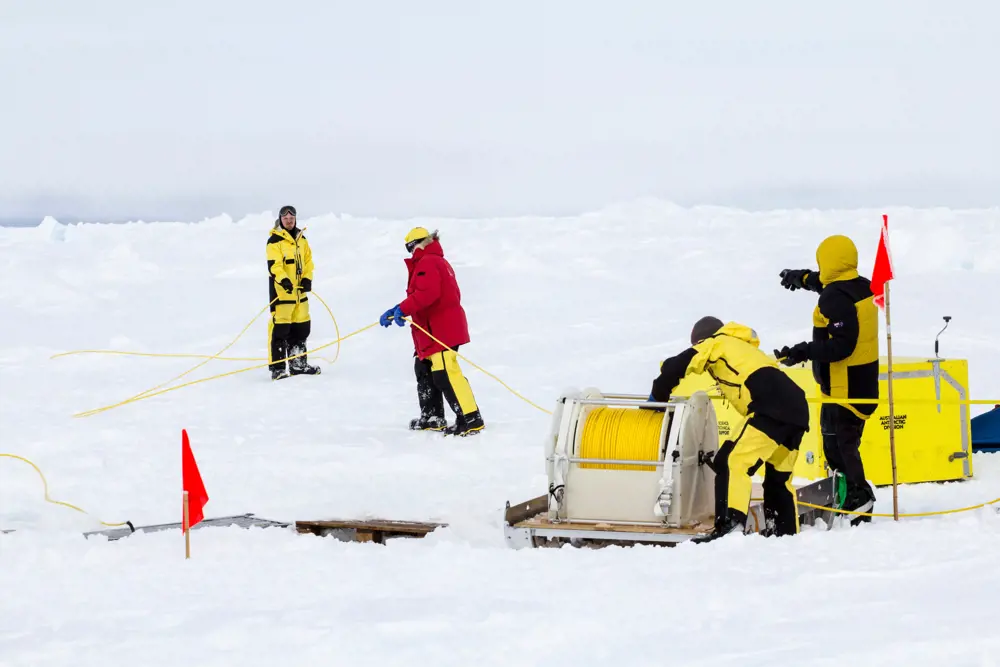
Scientists establishing an experiment using a remotely operated vehicle to explore ice algal growth under an ice floe. Temperatures at coastal stations are usually between -10°C and -30°C. On the high interior plateau, summer temperatures struggle to get above -20°C and monthly means fall below -60°C in winter © Shutterstock
At Halley, the most southerly of the BAS Antarctic Stations, winter darkness and frozen sea make access to the station possible during the austral summer only.
Energy provision
The predominant energy source for powering generators and equipment in Antarctica is hydrocarbon-based fuel. The production of electrical power, water and heat and the processing of waste products depend on oil. To increase sustainability, every effort is made to maximise the energy derived from fuel. Heat is recovered from the exhausts and water jackets surrounding generator engines.
Renewable energy systems are employed where feasible and have been successful on the sub-Antarctic islands of South Georgia. But the current wind generators and other renewable energy systems are not sufficiently reliable to be the routine primary power generator for the main Antarctic stations. The availability of power from renewable energy systems is also limited by environmental conditions – at some sites there are approximately 100 days of continuous darkness, which inevitably limits the effectiveness of solar collectors.
Antarctic operators focus on ensuring that energy use is reduced by enhancing insulation in buildings and encouraging personnel to optimise electrical power diversity (by ensuring that clothes are not washed at the same time as cooking is underway, for example). Maintaining a steady power load successfully reduces the energy demand.
Renewable energy systems are also limited by environmental conditions – at some sites there are approximately 100 days of continuous darkness, which inevitably limits the effectiveness of solar collectors.

The US National Oceanic and Atmospheric Administration (NOAA)'s Atmospheric Research Observatory, South Pole, Antarctica © NOAA
Living on ice
In the Antarctic most structures are erected on concrete plinths built on rock. The structures are formed from pre-fabricated panels. Although the insulation levels and other features are enhanced compared to the UK, these are not usually an extreme engineering challenge. Halley V is the British Antarctic Survey’s most southerly station and has been erected on the Brunt Ice Shelf at 750º South on the Weddell Sea. The original structures at Halley I were constructed for the 1956–1957 International Geophysical Year and were abandoned after 10 years when the station became buried 14 metres below the surface.
Any structure built on the surface at Halley becomes buried as the mean surface level raises each year by 1.5 metres due to blown snow. The ice shelf moves towards the sea at 400 m a year and any structure is then lost in the sea. Construction work can take place only during the Antarctic summer. Buildings and facilities in Antarctica must provide a standard of accommodation that will enable staff to live and work on site through the winter whilst keeping energy budgets under very tight control. Good laboratory facilities are also needed to enable world-class science to be delivered across many disciplines.
The standard of accommodation for personnel at Halley V is basic. Up to 18 members of ‘over-wintering’ staff have their own room, which is shared during the short summer with maintenance personnel. There are communal showers and toilets, a dining room, a small gym, a library and a doctor’s surgery and office. Water for the station is produced by melting snow and ice in an insulated melt tank using recovered heat from the generators. All macerated sewage and grey water is sent to a cavity under the station for disposal.
The exceedingly low temperatures encountered in Antarctica can only be overcome by working within known boundaries. Below -40ºC it is difficult, although not impossible, for staff to work outside for extended periods, even when equipped with appropriate clothing. Vehicles and plant with sump heaters can be started at -40ºC, although the hydraulic hoses may fracture. Using low-temperature steel safeguards the structural integrity of the buildings, but personnel can freeze to the steel unless adequately protected! Careful preparation is always needed to ensure that activities are completed only when environmental conditions permit.
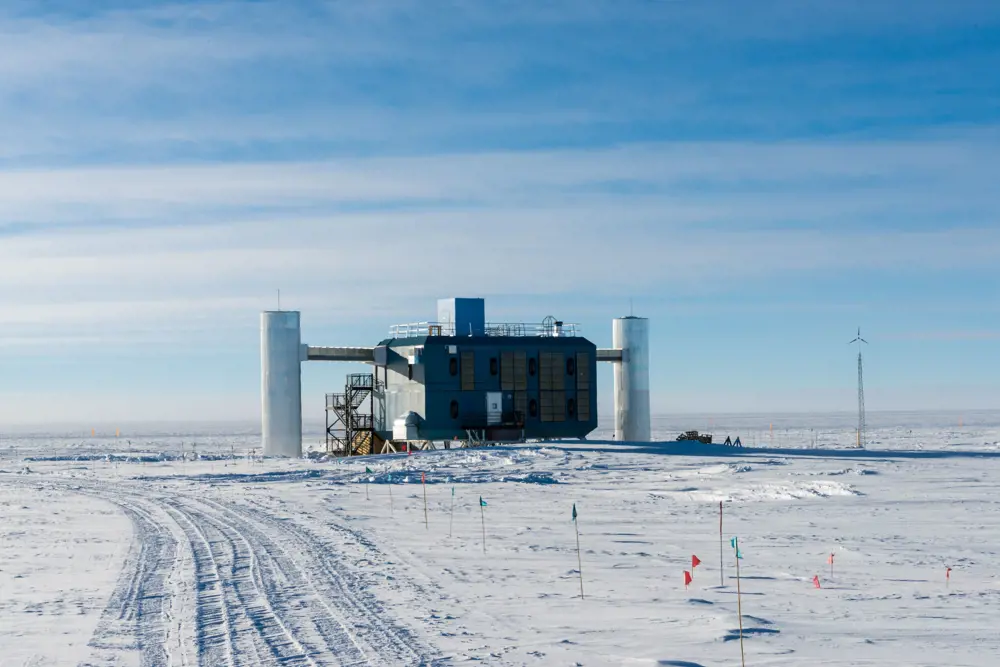
The biggest telescope on the planet, the IceCube Neutrino Observatory, is also on Antarctica. It's partially buried beneath the surface of the ice, to a depth of about 2,500 metres © Shutterstock / Jeff Warnock
Topsy turvy
Other unusual environmental conditions can cause difficulties: the very low humidity causes static problems with systems that store digital data and wooden buildings can become very dry, creating potential fire hazards. Similarly, high wind gusts and low temperatures can lead to the rapid failure of gearboxes on wind generators for example.
Changing seasons pose yet more problems. Ships and aircraft are generally used to carry passengers and materials into and around the Antarctic, and are also used to undertake survey missions and deep-sea science cruises. However, access to Halley is only possible by ship between late-December and mid-February each year, as the aircraft support is limited using the aircraft platforms available to BAS. It is therefore necessary to prepare all construction and maintenance activities for the very short austral summer. Major building programmes are not possible during the winter months when the over-wintering personnel experience up to 110 days of darkness and temperatures as low as-55ºC.
Months of total darkness at Halley can also lead to sleep disorders for personnel. However, despite the environmental extremes, a positive working spirit generally prevails. The over-wintering staff normally only work in Antarctica for a maximum of two and a half years, but to understand the vagaries and demands of working and living in Antarctica it is essential that all staff are fully trained and briefed before they travel south. To assist new entrants and ease staff handovers, a planned maintenance system and documented procedures are used to help with the completion of routine tasks. There is also a satellite communication link with BAS Cambridge available should the staff need specific assistance.
The original structures at Halley I were constructed for the 1956–1957 International Geophysical Year and were abandoned after 10 years when the station became buried 14 metres below the surface.
British Antarctic Survey, Science Programmes 2000–2005
Global change is happening more quickly in the Antarctic than anywhere else on earth, apart from Siberia and Alaska. British Antarctic Survey (BAS) carries out scientific programmes to investigate some of the key processes.
Signals of past global changes in Antarctica
BAS scientists collected data from sources including lake sediments, ice cores and air samples. Results from a European collaborative project into 740,000 years of ice core data show temperature and greenhouse gas fluctuations over eight glacial cycles. Carbon dioxide (CO2) and temperature track each other well except in the present day. CO2 concentrations are now the highest seen for 3/4 million years.
Antarctic climate processes
This programme aimed to gain insight into the roles of the atmosphere and oceans in regional and global climate. Increased summer air temperatures are thought to have caused the break-up of the Larsen B ice shelf. Global climate models have shown that this is linked to ozone loss and increased greenhouse gas levels.
Geospace – Atmosphere Transfer Functions
Atmospheric tides drive the upper atmosphere back and forth highlighting global changes due to human activity. The thinning of the ozone layer is thought to have caused a significant decrease in tides in the upper atmosphere. This is another example of how human activity is influencing the Earth’s atmosphere and in this case causing changes in the electric currents in the ionosphere (~125 km altitude) and the geomagnetic field on the ground.
Magnetic reconnection, substorms and their consequences
Energy from solar eruptions is channelled along the Earth’s magnetic field to the polar regions. It can disrupt terrestrial power supplies and satellites. BAS has developed a ‘minimal substorm model’ and results suggest that although storms may involve a variety of physical processes, the statistical properties can be obtained from a few simple rules which should, in the long term, help space weather predictions.
Global interactions of the Antarctic Ice Sheet
The Antarctic Ice Sheet is a crucial part of the Earth system – as a control on sea level and as a driver of global ocean circulation. This programme has investigated the evolution of the ice sheet and its behaviour over the past 10 million years. BAS discovered that on average glaciers on the Antarctic Peninsula have retreated by 50 m per year in the last five years, faster than at any time in the last 50 years. This confirms that the Peninsula ice sheet is extremely sensitive to recent warming and research now aims to determine whether or not this warming is caused by human activity.
Dynamics and management of ocean ecosystems
The Southern Ocean is biologically very rich and has a history of uncontrolled exploitation. The programme studied how human activity and climate changes will affect this marine environment and how biological communities will respond. The Antarctic Peninsula is one of the Earth’s most rapidly warming areas. It is a major nursery ground for krill, a shrimp-like crustacean at the heart of the food chain. BAS scientists have shown that krill have declined by 80% in the last 30 years which may be caused by a reduction in sea-ice. The breeding success of penguins and seals is affected by annual variations in the krill population.
Antarctic biodiversity – past, present and future
This programme set out to find out how past climatic change has influenced Antarctic marine communities and to assess the responses of terrestrial communities to present climate change. Research has shown that the marine communities contain a much higher biodiversity and species richness than previously thought. Studies of bacterioplankton in maritime Antarctic freshwater lakes suggest that they are highly sensitive to changes in their environment.
Life at the edge – stresses and thresholds
How does life manage to survive in the world’s most extreme cold environments? How will it adapt to climate changes? Research on ‘big’ (ie ~3 mm) land animals such as mites and springtails shows that they can change the temperatures at which they freeze. Studying terrestrial plants and animals under conditions that mimic environmental conditions predicted for Antarctica over the coming decades or hundreds of years (like rising temperature) shows that the communities in which they live become much more complex. For example, species not currently visible were able to germinate when conditions were suitable.
Antarctica in the Dynamic Global Plate System
The Earth has constantly changed during its evolution as tectonic events interact with atmospheric and climatic changes. This programme investigates how Antarctica broke away from the supercontinent, Gondwana, to move to its current location and how the Southern Ocean was formed. BAS scientists have discovered that 30–50 million years ago, South America and Antarctica split apart very rapidly. This led to the formation of the Drake Passage and resulted in a major cooling of Antarctica.
The new science programme Global Science in the Antarctic Context (2005–2010) builds on the successes of previous BAS research, surveying and monitoring while shifting the focus to important new areas such as air sea interactions and polar oceanography.
For more information see: www.antarctica.ac.uk
Communications available
Until the 2000s, internet access had not been possible for BAS personnel in the Antarctic and at time of writing, still remains that way for many Antarctic operators. The only practical method of communicating over broadband with the Antarctic is by using satellite connections. From a commercial perspective, there are only a few users of communications in Antarctica and in consequence no communications satellite is optimised for the Antarctic region.
The dial-up Inmarsat mobile satellite service has been available since the early 1980s. This system was originally developed for communicating with ships and the marine community, and although BAS Antarctic stations have used Inmarsat they are at the limit of the coverage footprint for the system. For scientific data to be transferred over Inmarsat and for staff to be able to send email to friends and relations, BAS developed software with compression routines to send email and data over the satellite. The high cost of using the 64 kilobits per second channel precluded routine telephone calls and access to the web.
But over the past two years, new VSAT (satellite systems that deliver broadband) ground stations have been installed on BAS stations and on ships to take advantage of commercial satellites, which can provide 24/7 connections. These satellites are still at their limit of coverage when communicating with Antarctica, but full duplex 128 kilobits per second (kbps) and 256 kbps channels enables data to be transferred on an IP link and allows routine web access. By integrating a voice over internet protocol (VoIP) telephone system, it is now possible to telephone Antarctic stations and ships as an internal telephone call to BAS. Working with communications systems suppliers has reduced significantly the routine cost and significantly enhanced the communications functionality in Antarctica.
Instrumentation
The installation of IT and communication systems has enhanced the ability to handle and process large volumes of data collected in the field. This equipment is either installed inside heated laboratories or radomes, which protect antennae.
Instruments that are installed at remote field sites however are often required to endure environmental extremes. One technique employed to power instruments has been to use highly insulated containers with photovoltaic panels and wind generators as power sources. Batteries are used to store power when energy supplies are available. Very low power but standard operating temperature range instruments operate at above zero degrees Centigrade. The design of the installation is carefully optimised to balance the insulation level of the container and the heat from the instruments. This form of design requires a significant volume of cargo to be carried into the field by aircraft, which is expensive because of the large number of flying hours required. Small, low power instruments with a wider temperature range present the opportunity to install equipment in smaller boxes – this approach has proved to be very successful and will be the preferred approach in the future. Often it is the power sources, particularly the wind generators, which are the least reliable component of the system.
Overcoming the harsh landscape
Antarctica presents one of the most challenging places to live and work in. Specific instruments and equipment are developed when there is a particular need and commercial products are not available, thus all equipment and systems are rigorously tested before deployment in Antarctica. The Antarctic environment is unforgiving and equipment will fail if it is not 100% suitable, and sending extra people and spare equipment to Antarctica is expensive and can be difficult to achieve in a short timescale.
To work safely and effectively in Antarctica staff must be fully trained and aware of limitations, and extensive pre-planning is needed to match delivery to objectives. For engineering equipment and systems it is often the simple and well-tried approach that produces the most successful and reliable product, and reliability and availability are particularly crucial when life support is to be considered.
The resulting scientific research that is enabled by overcoming these logistical hurdles is valuable and unique. The Antarctic Treaty of 1999 aptly summarised that there are few places in the world where there has never been war, where the environment is fully protected, and where scientific research has priority. But there is a whole continent like this, it is the land the Antarctic Treaty parties call "a natural reserve, devoted to peace and science".
Contributors
David Blake was Head of Technology and Engineering at the British Antarctic Survey where worked since 1991. His responsibilities include technology and engineering infrastructure in the Antarctic, ships and aircraft and he leads the Antarctic community's working group on sustainable energy and technology. He has previously worked as a Senior Engineer and Project Manager for the MoD and companies delivering instrumentation systems.
Keep up-to-date with Ingenia for free
SubscribeRelated content
Environment & sustainability
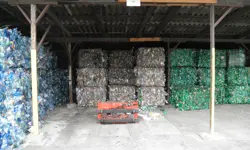
Recycling household waste
The percentage of waste recycled in the UK has risen rapidly over the past 20 years, thanks to breakthroughs in the way waste is processed. Find out about what happens to household waste and recent technological developments in the UK.
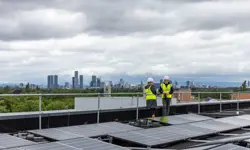
Upgrade existing buildings to reduce emissions
Much of the UK’s existing buildings predate modern energy standards. Patrick Bellew of Atelier Ten, a company that pioneered environmental innovations, suggests that a National Infrastructure Project is needed to tackle waste and inefficiency.
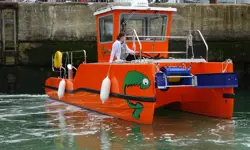
An appetite for oil
The Gobbler boat’s compact and lightweight dimensions coupled with complex oil-skimming technology provide a safer and more effective way of containing and cleaning up oil spills, both in harbour and at sea.

Future-proofing the next generation of wind turbine blades
Before deploying new equipment in an offshore environment, testing is vital and can reduce the time and cost of manufacturing longer blades. Replicating the harsh conditions within the confines of a test hall requires access to specialist, purpose-built facilities.
Other content from Ingenia
Quick read

- Environment & sustainability
- Opinion
A young engineer’s perspective on the good, the bad and the ugly of COP27

- Environment & sustainability
- Issue 95
How do we pay for net zero technologies?
Quick read

- Transport
- Mechanical
- How I got here
Electrifying trains and STEMAZING outreach

- Civil & structural
- Environment & sustainability
- Issue 95